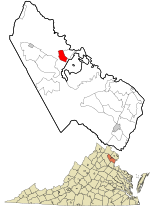Ben Lomond Plantation

Ben Lomond, also known as Ben Lomond Plantation, is a historic plantation house located at Bull Run, Prince William County, Virginia. It was built in 1837, and is a two-story, five-bay, red sandstone dwelling with a gable roof. The house has a central-hall plan and one-story frame kitchen addition. One-story pedimented porches shelter the main (north) and rear (south) entries. Also on the property are the contributing frame two-story tenant's house, brick pumphouse, and a bunkhouse dated to the early 20th century; and a meat house, dairy, and slave quarters dated to the late-1830s.It was listed on the National Register of Historic Places in 1980.The house is owned by the County and is open for tour as a Civil War-period historic house museum.
Excerpt from the Wikipedia article Ben Lomond Plantation (License: CC BY-SA 3.0, Authors, Images).Ben Lomond Plantation
Sudley Manor Drive,
Geographical coordinates (GPS) Address Nearby Places Show on map
Geographical coordinates (GPS)
| Latitude | Longitude |
|---|---|
| N 38.788333333333 ° | E -77.505833333333 ° |
Address
Old Rose Garden
Sudley Manor Drive
20109
Virginia, United States
Open on Google Maps








